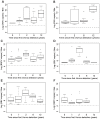On the front line: quantitative virus dynamics in honeybee (Apis mellifera L.) colonies along a new expansion front of the parasite Varroa destructor
- PMID: 25144447
- PMCID: PMC4140857
- DOI: 10.1371/journal.ppat.1004323
On the front line: quantitative virus dynamics in honeybee (Apis mellifera L.) colonies along a new expansion front of the parasite Varroa destructor
Abstract
Over the past fifty years, annual honeybee (Apis mellifera) colony losses have been steadily increasing worldwide. These losses have occurred in parallel with the global spread of the honeybee parasite Varroa destructor. Indeed, Varroa mite infestations are considered to be a key explanatory factor for the widespread increase in annual honeybee colony mortality. The host-parasite relationship between honeybees and Varroa is complicated by the mite's close association with a range of honeybee viral pathogens. The 10-year history of the expanding front of Varroa infestation in New Zealand offered a rare opportunity to assess the dynamic quantitative and qualitative changes in honeybee viral landscapes in response to the arrival, spread and level of Varroa infestation. We studied the impact of de novo infestation of bee colonies by Varroa on the prevalence and titres of seven well-characterised honeybee viruses in both bees and mites, using a large-scale molecular ecology approach. We also examined the effect of the number of years since Varroa arrival on honeybee and mite viral titres. The dynamic shifts in the viral titres of black queen cell virus and Kashmir bee virus mirrored the patterns of change in Varroa infestation rates along the Varroa expansion front. The deformed wing virus (DWV) titres in bees continued to increase with Varroa infestation history, despite dropping infestation rates, which could be linked to increasing DWV titres in the mites. This suggests that the DWV titres in mites, perhaps boosted by virus replication, may be a major factor in maintaining the DWV epidemic after initial establishment. Both positive and negative associations were identified for several pairs of viruses, in response to the arrival of Varroa. These findings provide important new insights into the role of the parasitic mite Varroa destructor in influencing the viral landscape that affects honeybee colonies.
Conflict of interest statement
The authors have declared that no competing interests exist.
Figures





Similar articles
-
Parasite and virus dynamics in the honeybee Apis mellifera unicolor on a tropical island recently invaded by Varroa destructor.J Invertebr Pathol. 2024 Jun;204:108125. doi: 10.1016/j.jip.2024.108125. Epub 2024 May 4. J Invertebr Pathol. 2024. PMID: 38705353
-
Transmission of deformed wing virus between Varroa destructor foundresses, mite offspring and infested honey bees.Parasit Vectors. 2022 Sep 23;15(1):333. doi: 10.1186/s13071-022-05463-9. Parasit Vectors. 2022. PMID: 36151583 Free PMC article.
-
Acaricide treatment affects viral dynamics in Varroa destructor-infested honey bee colonies via both host physiology and mite control.Appl Environ Microbiol. 2012 Jan;78(1):227-35. doi: 10.1128/AEM.06094-11. Epub 2011 Oct 21. Appl Environ Microbiol. 2012. PMID: 22020517 Free PMC article.
-
Understanding the Enemy: A Review of the Genetics, Behavior and Chemical Ecology of Varroa destructor, the Parasitic Mite of Apis mellifera.J Insect Sci. 2022 Jan 1;22(1):18. doi: 10.1093/jisesa/ieab101. J Insect Sci. 2022. PMID: 35137134 Free PMC article. Review.
-
Emerging and re-emerging viruses of the honey bee (Apis mellifera L.).Vet Res. 2010 Nov-Dec;41(6):54. doi: 10.1051/vetres/2010027. Epub 2010 Apr 29. Vet Res. 2010. PMID: 20423694 Free PMC article. Review.
Cited by
-
Effects of Deformed Wing Virus-Targeting dsRNA on Viral Loads in Bees Parasitised and Non-Parasitised by Varroa destructor.Viruses. 2023 Nov 15;15(11):2259. doi: 10.3390/v15112259. Viruses. 2023. PMID: 38005935 Free PMC article.
-
The power and promise of applying genomics to honey bee health.Curr Opin Insect Sci. 2015 Aug 1;10:124-132. doi: 10.1016/j.cois.2015.03.007. Curr Opin Insect Sci. 2015. PMID: 26273565 Free PMC article.
-
Evaluation of the Potential Effect of Postbiotics Obtained from Honey Bees against Varroa destructor and Their Combination with Other Organic Products.Insects. 2024 Jan 17;15(1):67. doi: 10.3390/insects15010067. Insects. 2024. PMID: 38249073 Free PMC article.
-
Foodborne Transmission of Deformed Wing Virus to Ants (Myrmica rubra).Insects. 2019 Nov 7;10(11):394. doi: 10.3390/insects10110394. Insects. 2019. PMID: 31703426 Free PMC article.
-
Behavioral Genetics of the Interactions between Apis mellifera and Varroa destructor.Insects. 2019 Sep 16;10(9):299. doi: 10.3390/insects10090299. Insects. 2019. PMID: 31527402 Free PMC article.
References
-
- Loreau M, Naeem S, Inchausti P, Bengtsson J, Grime J, et al. (2001) Biodiversity and ecosystem functioning: current knowledge and future challenges. Science 294: 804–808. - PubMed
-
- Potts SG, Biesmeijer JC, Kremen C, Neumann P, Schweiger O, et al. (2010) Global pollinator declines: trends, impacts and drivers. Trends in Ecology & Evolution 25: 345–353. - PubMed
-
- UNEP (2010) Global honey bee colony disorders and other threats to insect pollinators; Issues UE, editor: UNEP Emerging Issues.
Publication types
MeSH terms
LinkOut - more resources
Full Text Sources
Other Literature Sources
Medical
Miscellaneous

